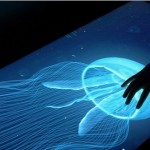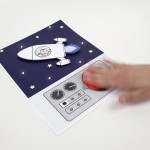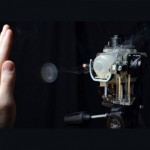Tag Archives: disney research
Jimmy the Robot Puppet Holds Things Oh So Gently
Meet Jimmy, an innocent looking robot from Disney Research. They gave him hands that are basically drumsticks with soft pads. It shouldn’t run wild and harm anyone, since it is a remote operated robot, and not autonomous.
Jimmy was developed by scientists from Disney Research, the Catholic University of America, and Carnegie Mellon University. Jimmy is pretty good at handling delicate objects like eggs (and smashing them on command). You can check out a few videos of Jimmy in action below.
What is most impressive is that without his rubber paws on, Jimmy can thread a needle faster than most humans can. That is some amazing precision control. Jimmy can also safely interact with humans, touching their faces without breaking their skulls, which is always nice in a robot.
[via Geeks Are Sexy]
Disney Research Invents AR-Enabled Drawing Books

The void between bi-dimensional drawing books and theme parks needed to be filled somehow, and Disney Research figured out that augmented reality might fit well in the mix.
Disney Research is by no means the first to bring coloring books and mobile apps together, as that merit belongs to Crayola and its Color Alive line. However, Disney’s recent invention is a tad more ambitious, as it makes use of AR to make it look like the characters colored by the kids are displayed in three dimensions.
Authored by Stéphane Magnenat, Fabio Zund, Mattia Ryffel, Gioacchino Noris, Gerhard Röthlin, Alessia Marra, Maurizio Nitti, Markus Gross and Bob Sumner of Disney Research Zurich, along with Dat Tien Ngo and Pascal Fua of Computer Vision Lab, EPFL, Switzerland, the research paper titled Live Texturing of Augmented Reality Characters from Colored Drawings (available here as a PDF file) pushes new boundaries in the way children express their creativity. Presented on the first day of ISMAR (International Symposium on Mixed and Augmented Reality) 2015, which took place between September 29 and October 3 in Fukuoka, Japan, the paper explains how digital devices are making their way even in the lives of very young children, and in this context, real-world tasks such as drawing might might seem less interesting. The solution is to bring augmented reality into the mix, so that digital devices and activities can be bridged together in a unique manner.
Developed simply as a concept, the AR coloring book presented in this paper means to show the potential of this technology. If there’s plenty of positive feedback around Disney Research’s experiment, I’m sure that plenty other augmented reality drawing books will follow. As a matter of fact, why stop the whole thing at books for kids? Geometry and even architecture would look fabulous in AR. Imagine how that could put things in a new perspective.
Back to the matter at hand, though, each character from the AR coloring book appears blank, but in 3D on the smartphone or tablet’s display, assuming that the mobile device is running the AR app developed by Disney Research. As soon as the kids get on with coloring the character, the colors are reproduced in high fidelity on the 3D figure, as well.
Probably the best part about this whole thing is that the novel texturing process developed by Disney Research applies the texture from the AR book to both the visible and occluded sides of the character. In other words, if kids are coloring the book and the mobile device running the AR app is moved around the book, they will be able to see both the front (which has been colored by them) and the back of the character. In other words, the app is deducing how the character should look like on the invisible sides.
The work of the Disney Research Zurich team has been validated with two user studies, so there’s no doubt that kids are more attracted to AR drawing books than the bland conventional ones.
Be social! Follow Walyou on Facebook and Twitter, and read more related stories about Disney Research’s accurate method of 3D-printing human hair, or Disney’s layered fabric 3D printer.
Via: Toyland
Disney Unveils the Prototype of a Layered Fabric 3D Printer

3D printing materials are no longer limited to ABS or PLA, as researchers are continuously looking to increase the number of options. The latest invention comes from Disney Research in the form of soft fabric that can be 3D printed in layers.
Disney Research seems to be focusing on the oddest things possible, some of the topics of interest including colorful swarms of Pixelbots or 3D printed human hair. Their latest addition to a long line of peculiar inventions is a 3D printer that relies on soft fabric and adhesive to create fluffy objects. That’s definitely a different take on 3D printing, a field where the majority of the resulting objects were rock hard.
The researchers behind the layered fabric 3D printer are aware that this is not the industry’s first attempt to create flexible objects using this process of manufacture. However, their unusual approach will not go unnoticed, as there are quite a few applications.
Using fabric lead to some significant changes in the 3D printing process, as there is some laser cutting involved. Even though it may seem that there are just sheets of fabric layered one on top of another, each of these layers is cut in 2D so that its perimeter matches the external area of the 3D object. The resulting block of fabric includes the object, as well as the support material, which can be easily peeled away.
Disney Research also exemplified in the above video how long cuts in the fabric layers could be used for reinforcing an object, conditioning its flexibility by changing the bending direction.
Obviously, one of the main applications for this new 3D printing method is the creation of toys for toddlers, as they are not old enough to play with plastic toys. I’m not yet sure how the conductive fabric showcased in the above video could be put to some good use, but that remains to be seen in the future.
We have to keep in mind that this 3D printer is currently just a prototype, and that the items that were printed so far can’t match the energy levels, nor the determination of a toddler. In conclusion, Disney Research might have to spend some additional time on perfecting this 3D printing method.
Be social! Follow Walyou on Facebook and Twitter, and read more related stories about Disney’s swarms of Pixelbots or Disney Research’s 3D printed human hair.
Disney Research Found a Way to 3D Print Human Hair Accurately

It may seem that the things invented or developed by Disney Research aren’t in any way related to what The Walt Disney Company does, by eventually, the concepts are seen either at Disneyworld or in the movies produced by this corporation.
This will also probably be the case with 3D printed stylized hair, the latest feat of Disney’s research labs. The deed is even more spectacular as until now it was believed that reproducing human hair through 3D printing was impossible. Mind you, Disney Research’s approach may not be perfect, as they haven’t managed to 3D print individual strands of hair. Instead, they proceeded to getting an accurate impression of a person’s hairstyle by fitting it on bust.
The result will make its way to souvenir shops from around The Magic Kingdom, as the masterminds at Disney Research claimed that the 3D printed hair will be used on figurines. More than that, facial hair will also be easy to reproduce using this method. I know that it’s not from a Disney movie, but I’d love to see Community’s Star-Burns as a figurine.
The paper detailing how 3D printing was used to achieve this will be presented at ACM Conference on Computer Graphics & Interactive Techniques (SIGGRAPH) 2014. Dr. Derek Bradley, associate research scientist at Disney Research Zurich, one of the participants at this project, explained that “Almost as much as the face, a person’s hairstyle is a defining characteristic of an individual. The resulting figurine loses a degree of realism when the individual’s hairstyle isn’t adequately captured.”
Along with Bradley, other scientists that were part of the team include Jose Ignacio Echevarria and Diego Gutierrez from Universidad de Zaragoza, as well as Thabo Beeler (DR Zürich).
Disney Research admits that 3D printing human (or animal, as there are plenty of animals in Disney flicks) hair fiber by fiber is impossible using current 3D printers. I’m pretty sure that in the not-so-distant future, we’ll have the technology for that as well. The advancements in bio-printing will enable people to 3D print wigs, and maybe even get rid of baldness, in the process. We just have to be patient, as there are plenty of brilliant minds willing to make the world better, one 3D printed object at a time.
Be social! Follow Walyou on Facebook and Twitter, and read more related stories about Disney Aireal, which enhances Kinect with tactile feedback, and Disney Research animatronic robot that plays catch.
Disney Wants Us to Feel the Things Displayed on Touchscreens
Disney Interactive Children’s Books Built With Paper Generators
Disney Aireal Enhances Kinect Gaming with Tactile Feedback
Disney Research develops capacitive touch that detects multiple users through their fingertips (video)
Creating a truly multi-user, multi-touch display is a tricky prospect. How do you know who's who short of turning the screen into one giant fingerprint reader? Chris Harrison, Ivan Poupyrev and Munehiko Sato at Disney Research have suggested in a paper that fingerprinting on a capacitive touchscreen isn't far off -- it's just what we need to fingerprint that matters. Rather than look for physical ridges, the scientists' method sweeps through AC frequencies to find the exact electrical impedances of fingertips in contact with the screen. Different bodies, different clothes and even different shoes give everyone a unique signature that lets the screen identify specific people, even when they each have multiple fingers in play. The researchers propose that the technique would work well in collaborative workspaces, personalized devices and security, but let's not forget that this is Disney we're talking about: it's placing a strong emphasis on the prospects for shared screen gaming without the limitations we know today. While any practical use is still some distance away, it's easy to see future tablets and tables that are designed from the start to encourage a little socializing.
Filed under: Gaming, Tablets, Science, Alt
Disney Research develops capacitive touch that detects multiple users through their fingertips (video) originally appeared on Engadget on Tue, 09 Oct 2012 16:29:00 EDT. Please see our terms for use of feeds.
Permalink | Disney Research | Email this | Comments
Disney Research | Email this | Comments 

 What if we could feel the texture of the things we see on our smartphones and tablets? Disney Research’s latest …
What if we could feel the texture of the things we see on our smartphones and tablets? Disney Research’s latest … Disney has in store for us a new way of interacting with children’s books. We might be able to generate …
Disney has in store for us a new way of interacting with children’s books. We might be able to generate …
 The latest product coming from Disney Research is a device that generates force-feedback while gaming, thus making the experience more …
The latest product coming from Disney Research is a device that generates force-feedback while gaming, thus making the experience more …